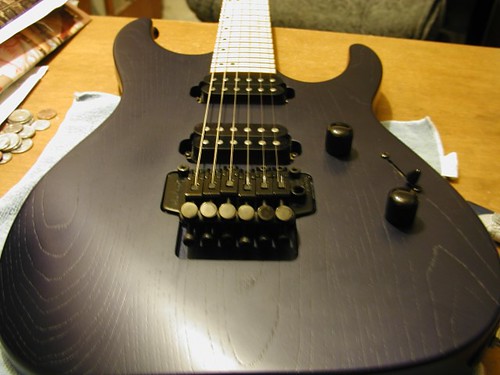If you don't fill the wood - you'll end up with grain lines showing in the final finish
If you're gonna solid color it, may I humbly suggest the super glue route, as I'm totally pleased with the results. You can use other water based or oil based fillers, but on a wood like swamp ash, with its deep deep grain... I really like how the superglue went in, dried fast, and was level in about 1/16 the time as traditional old school grain fill.
I actually took the wood surface down to 400 grit, and there's not really any detection of grain at all after it was leveled. I used 320grit "3x" paper (Home Depot) on a Dewalt 1/4 sheet sander for the leveling and for the 400 grit final. The trick is to not press in at all and to keep the sander moving all over (heat builds up). You could do a first level with a sander to save elbow grease, then switch to a traditional block if you're skittish about keeping things totally flat with a power saner (you can end up with non flat wood REAL quick so be careful).
Let me add a bit about non-flat wood. When you sand using a block, its slow enough that hardly any heat is generated. The wood does not expand much at all while you sand. When you use a sander, it is possible - through too much sanding on one area, or through too much pressure - to raise the wood along its natural expansion. On ash, that means the light areas and dark areas will react differently when they get warm, and the swelling will be uneven. The lighter (denser) areas will swell more, and you'll end up with the darker (less dense) areas being sunken when it cools off. That is NOT desirable for a good finish. So, either hit the superglue in its rough sate with the sander, then switch to a 3m block, OR, be real careful with the sander, and keep fresh paper on it, and clean the paper well and frequently. Don't use more pressure if the area is still rough. In fact, just keep moving around and come back there occasionally. You don't want things to get hot by leaving the sander in a small area, so keep moving. Similarly, you don't want to add pressure - which makes more heat, so keep a light touch and fresh paper - which cuts better and creates less heat in so doing.
The same holds true when power sanding any wood really, no matter the finish... CA, lacquer, filler, poly... its all the same when heat is involved.
If you want a smooth finish, you want that wood to be just about as smooth as the finished guitar - BEFORE - you spray it.
If you're using lacquer - there's much added benefit from having level wood. The lacquer goes on evenly, and it dries evenly, with less shrinkage into the grain. This allows for leveling of the orange peel with less cure time, and promotes an overall smooth finish and one that continues to stay smooth as it shrinks.



